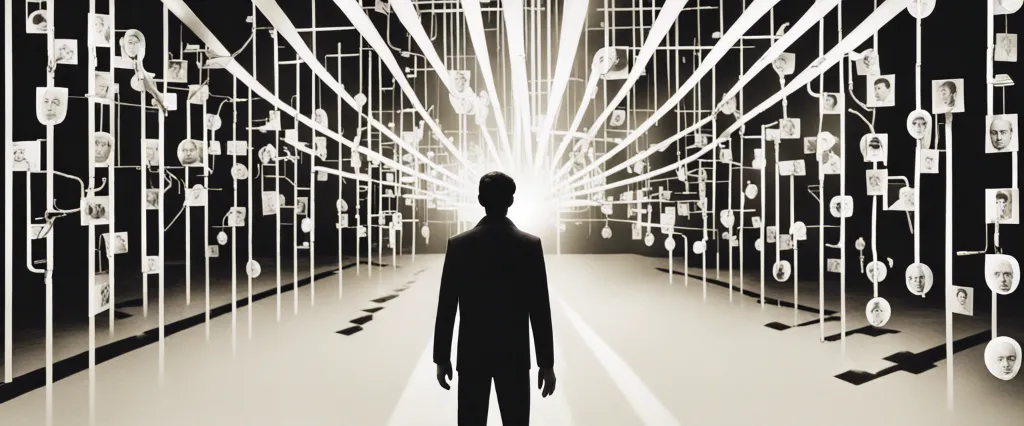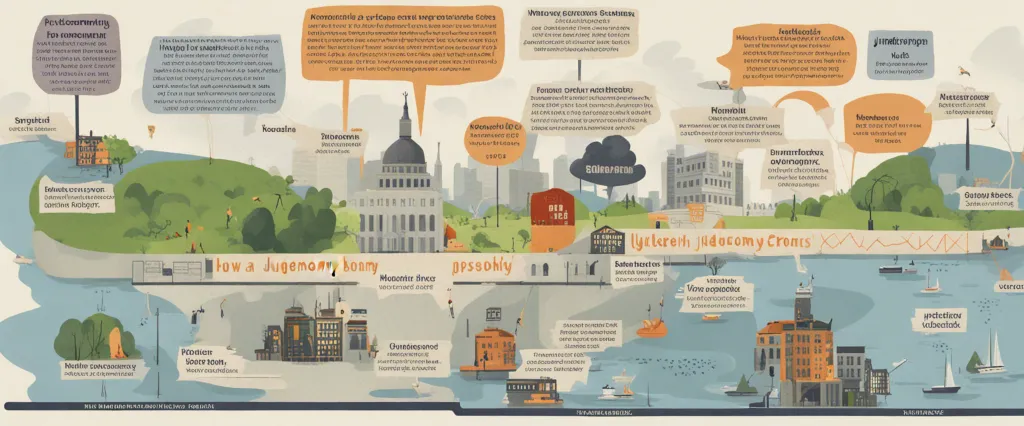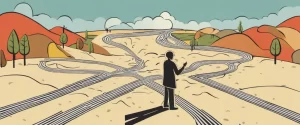——How An Economy Grows And Why It Crashes by Peter D. Schiff & The Paradox of Choice by Barry Schwartz

In the vast world of literature, books that provide insight into the complexities of economics and human behavior hold a special place. Two such remarkable works, Peter D. Schiff’s “How An Economy Grows And Why It Crashes” and Barry Schwartz’s “The Paradox of Choice,” delve deep into these intertwined realms, offering distinctive perspectives that shed light on how individuals and societies function. Despite their seemingly divergent subjects—an allegorical exploration of economic principles and a discourse on decision-making—the underlying theme connecting these books emerges: the intricate relationship between human choices and their consequences.
Peter D. Schiff’s “How An Economy Grows And Why It Crashes” takes readers on a captivating journey, framed through an insightful allegory that unravels the secrets of economic growth and failure. The book skillfully utilizes a fictional island economy, illustrating how individuals, entrepreneurs, and governments interact to shape the trajectory of a nation. Schiff’s work not only educates readers about economic concepts, but also empowers them to comprehend the inner workings of economic systems by introducing characters and vivid scenarios that resonate beyond the realm of theories and models.
On the other hand, Barry Schwartz’s “The Paradox of Choice” delves into the intriguing realm of decision-making, illuminating the intricate relationship between choices and our overall well-being. Schwartz challenges the conventional notion that an abundance of choices leads to increased satisfaction and argues that it often overwhelms and paralyzes individuals. By delving into psychological research and real-life examples, the book explores the fascinating dynamics of choice—from the cognitive processes that govern our decision-making to the implications of too many choices on our happiness and personal fulfillment.
While Schiff and Schwartz delve into different subjects, both books profoundly explore the psychological, economic, and social implications of human choices. “How An Economy Grows And Why It Crashes” probes the consequences of collective choices on the stability and growth of an economy, while “The Paradox of Choice” examines the individual implications of the choices we make on our overall well-being. Both authors invite readers to reflect upon the factors that shape our decision-making processes and prompt us to ponder the consequences of our actions.
In this comparative study, we will delve into the core concepts presented in each book, examining how they intersect and diverge. By exploring the nuances within Schiff and Schwartz’s works, we will unravel the intricate relationship between economics and decision-making, ultimately illuminating the complex interplay between individual choices and the broader socio-economic landscapes in which they occur.
Through the exploration of these captivating works, readers will gain a deeper understanding of the forces at play within both the microcosm of personal choice and the macrocosm of societal systems. As we embark on this comparative journey, let us open our minds to the fascinating insights and wisdom that lie within the pages of both “How An Economy Grows And Why It Crashes” and “The Paradox of Choice.”
Brief Summary of Two Books
How An Economy Grows And Why It Crashes by Peter D. Schiff
How an Economy Grows and Why It Crashes” is a book written by Peter D. Schiff that provides a simplified explanation of how economies work and the reasons behind their potential collapse. The book presents its ideas through a fictional narrative, following the adventures of three characters on a mythical island who explore various economic concepts.
The story starts with the description of a small island where only two individuals, Able and Cain, reside. Able engages in fishing, while Cain grows crops, and they start trading resources to improve their lives. Through their interactions, Schiff elucidates essential economic principles like division of labor, specialization, and the benefits of trade.
Over time, the island’s population grows, and its economy becomes more complex. Schiff introduces new characters and concepts, discussing the roles of banks, credit, savings, and investment. He demonstrates how a growing economy requires a stable currency, reliable savings, and productive investments to flourish.
However, the book also delves into the potential pitfalls that can lead to economic crashes. Schiff warns against excessive borrowing and government intervention in the economy. He explains the dangers of inflation, unsustainable credit expansion, and the misallocation of resources caused by central planning.
Throughout the narrative, Schiff emphasizes the importance of sound economic policies and individual responsibility. He argues that government interventions, such as artificially low interest rates, can create temporary booms but ultimately lead to painful market corrections.
In summary, “How an Economy Grows and Why It Crashes” uses a fictional story to explain fundamental economic principles and their impact on growth and stability. Schiff advocates for free-market principles and highlights the potential consequences of government interventions. The book aims to provide readers with a clear understanding of how economies function and the risks they face.
The Paradox of Choice by Barry Schwartz
“The Paradox of Choice” by Barry Schwartz explores the impact of having too many choices in our lives, leading to decision paralysis and dissatisfaction. Schwartz argues that while we believe more options will make us happier, the abundance of choices often overwhelms us and makes it difficult to make decisions. He highlights how our consumer culture bombards us with choices and how this abundance has infiltrated every aspect of our lives, from career paths to relationships.
Schwartz delves into the psychological and emotional consequences of decision-making and the toll it takes on our well-being. He discusses the concept of “maximizers” and “satisficers” – individuals who aim for the absolute best versus those who are content with good enough, respectively. While maximizers may seem more successful, Schwartz argues that satisficers have a higher level of life satisfaction and overall happiness, as they save time and energy by not getting caught in the never-ending quest for the perfect choice.
The author also explores how having too many choices can lead to elevated expectations and a fear of making the wrong decision. Additionally, the book examines the impact of regret, as people who have made choices often wonder if they could have done better had they chosen differently. Schwartz suggests that society could benefit from reducing the number of choices to alleviate decision fatigue and increase overall happiness.
Overall, “The Paradox of Choice” challenges the popular notion that more options lead to better outcomes and provides insights into how we can navigate the modern world of overwhelming choices to lead happier, more fulfilling lives.
Comparison between Two Books

Similarities in Economics
Both “How an Economy Grows and Why It Crashes” by Peter D. Schiff and “The Paradox of Choice” by Barry Schwartz discuss different aspects of economics, but they share some similarities:
1. Understanding the consequences of decisions: Both books emphasize the importance of understanding the long-term consequences of economic decisions. “How an Economy Grows and Why It Crashes” explores the impact of government intervention and unsound monetary policies on economies, while “The Paradox of Choice” delves into the effects of choice overload on individuals and society.
2. Importance of efficient resource allocation: Both books highlight the significance of efficient resource allocation. “How an Economy Grows and Why It Crashes” emphasizes the concept of capital accumulation and investment, while “The Paradox of Choice” discusses the need to prioritize and allocate our limited time, attention, and energy effectively.
3. The role of incentives: Both books touch upon the role of incentives in shaping economic behavior. “How an Economy Grows and Why It Crashes” discusses the impact of incentives on entrepreneurs and consumers, and how government interventions can distort these incentives. In “The Paradox of Choice,” Schwartz explores how the availability of options and different incentives can affect decision-making processes.
4. The potential dangers of unchecked growth: While approaching the topic from different angles, both books explore the potential dangers of unchecked growth. “How an Economy Grows and Why It Crashes” discusses how unsustainable economic policies can lead to crashes and recessions, while “The Paradox of Choice” warns of the negative consequences of excessive options and choices.
5. The importance of economic education and understanding: Both books emphasize the need for individuals to have a basic understanding of economics. “How an Economy Grows and Why It Crashes” seeks to simplify and teach economics through a parable, while “The Paradox of Choice” aims to inform individuals about the psychological aspects of decision-making in an increasingly complex and consumer-driven world.
While these books approach economics from different angles, they both shed light on important aspects of economic decision-making, resource allocation, incentives, and the potential pitfalls of unchecked growth.
Divergences in Economics
“How An Economy Grows And Why It Crashes” by Peter D. Schiff and “The Paradox of Choice” by Barry Schwartz are two books that discuss different aspects of economics from contrasting perspectives. While both books touch upon economic principles and their effects on individual and collective outcomes, they diverge in terms of their focus and the messages they convey.
In “How An Economy Grows And Why It Crashes,” Peter D. Schiff offers an accessible exploration of the basic principles of economics through a storytelling approach. He presents a narrative to explain how economies grow and prosper by focusing on the concepts of production, savings, and investment. Schiff emphasizes the importance of limited government intervention and sound monetary policies to ensure sustainable economic growth. The main focus of this book lies in conveying the significance of free markets and highlighting the unintended consequences of government interventions in driving economic development.
On the other hand, “The Paradox of Choice” by Barry Schwartz delves into the psychological aspects of decision-making and its relationship to economics. Schwartz argues that while choice is typically considered a desired freedom, the abundance of choices in modern societies can lead to increased anxiety, decision fatigue, and dissatisfaction. The book explores how the expanding range of choices in various domains, including economics, often fails to generate the expected happiness and fulfillment. Schwartz suggests that a reduction of options and a shift towards simplicity can alleviate the negative effects of overwhelming choice.
The main divergence in these books lies in their focus on different aspects of economics. Schiff’s book primarily explores macroeconomic principles, emphasizing the importance of free markets and limited government intervention in driving economic growth. In contrast, Schwartz’s book focuses more on the psychological impact of choice and its implications for individual well-being and satisfaction, touching on the intersection of economics and psychology.
Furthermore, while Schiff’s book presents a straightforward narrative and incorporates humor to engage readers, Schwartz’s book delves into the complex psychological dynamics of choice, drawing on experiments and research studies to support his perspectives. The writing styles and approaches of the authors differ, with Schiff adopting a more instructional and informative tone, while Schwartz’s writing is analytical and introspective.
In summary, “How An Economy Grows And Why It Crashes” and “The Paradox of Choice” diverge in their focus on economics. Schiff’s book concentrates on explaining the principles of economic growth and the importance of free markets, while Schwartz’s book delves into the psychological effects of choice and its impact on individual well-being. Both books offer valuable insights into different dimensions of economics, providing readers with contrasting perspectives on the subject matter.

Conclusion
Both “How An Economy Grows And Why It Crashes” by Peter D. Schiff and “The Paradox of Choice” by Barry Schwartz are highly regarded books that provide unique perspectives on different aspects of life. The choice between the two ultimately depends on your personal interests and what you aim to gain from reading.
If you are interested in understanding the economy, its growth, and the reasons behind its crashes, then “How An Economy Grows And Why It Crashes” by Peter D. Schiff is the more suitable choice. Peter D. Schiff, an economist and investment advisor, explains complex economic concepts in a straightforward and engaging manner. This book provides insights into the fundamentals of the economy and how various factors contribute to its rise and fall.
On the other hand, if you are interested in exploring the impact of choices and decision-making in different aspects of life, then “The Paradox of Choice” by Barry Schwartz is a better option. Barry Schwartz, a psychologist, delves into the paradoxical nature of having too many choices and how it can lead to decision paralysis, dissatisfaction, and regret. This book offers valuable insights on how to navigate the overwhelming number of choices we face in society.
Both books provide unique and valuable perspectives, but it ultimately depends on your interests and what you hope to gain from reading.


